Author: E2M Research Source: mirror
With the emergence of more and more public chains and Layer 2, the current Web3 experience is very fragmented. Different chains incentivize users to use their networks exclusively and require different wallets to interact with them. At the same time, the protocol decides which chain to deploy by prioritizing joint marketing campaigns, TVL, and market sentiment, rather than technology or innovation. This creates an siled and incompatible ecosystem that hinders the development of Web3.
Particle Network's solution to this problem is chain abstraction: simplifying users' interaction with the blockchain, allowing them to use any product and asset without having to worry about management Multiple wallets, bridges, underlying blockchains, and more.
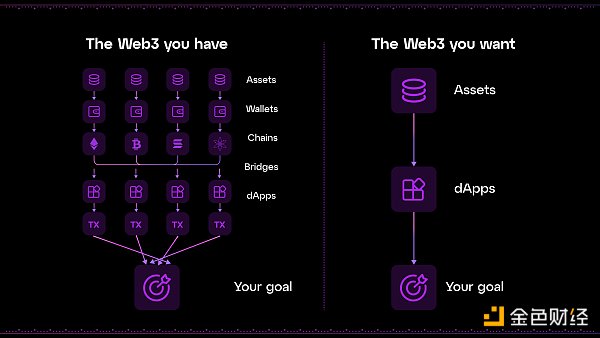
Particle Network launched in 2022, initially as a wallet abstraction service provider. After over 17 million wallet activations and over 900 dApp integrations, Particle is evolving further, launching a modular L1 chain abstraction network to build a universal settlement layer across the EVM and BTC ecosystems.
Network architecture
Particle Network is built through Cosmos SDK, which can better realize modular design , retaining sovereignty while outsourcing key functions such as verification and data availability to dedicated ecosystem players. It also allows us to leverage Cosmos’ Inter-Blockchain Communication (IBC) protocol for interoperability, enabling cheap and fast cross-chain transaction execution.
Particle Network has a dual pledge system that combines proof of equity through Tendermint with EigenLayer's ReStaking to improve network security. The double pledge mechanism sets up two different operator pools: one is the delegation pool of Particle Network’s native token, and the other is the ETH delegation pool using EigenLayer. The two pool nodes must independently agree on the validity to ensure equal participation in the consensus. This dual-staking model bootstraps the network through the security provided by re-staking ETH, significantly reducing security reliance on Particle Network’s native token during the initial launch period.
In addition, it provides a unique Aggregation of Data Availability (AggDA) model that relies on providers such as NEAR DA, Celestia, EigenDA, and Avail.
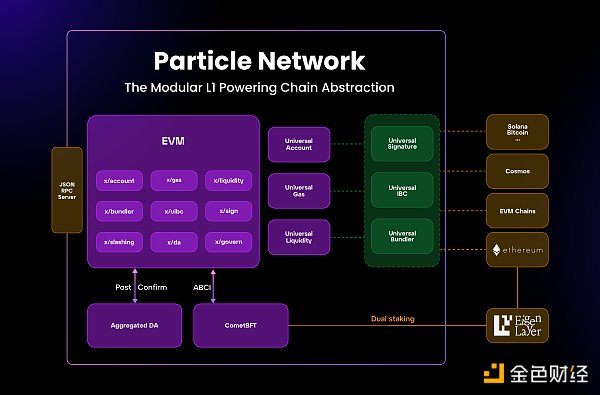
According to the latest news, Particle Network's V1 testnet is expected to be released in the second quarter of 2024, and the V2 mainnet will be released in the fourth quarter of 2024.
The network relies on three core modules:
Generic accounts:
These are custom ERC-4337 smart account implementations. Through these accounts, Particle Network simplifies the management and use of smart contract wallets on all EVM chains and allows them to control accounts on heterogeneous blockchains such as Bitcoin and Solana.
Universal liquidity:
Unify the liquidity of all chains through multi-chain atomic transaction execution. This allows users to interact with the new chain without holding tokens.
Universal Gas Token:
Allow users to use universal Gas Token to pay Gas for cross-chain transactions, instead of using Gas Token of different chains (SOL, ETH, MATIC, etc.) in a multi-chain ecosystem
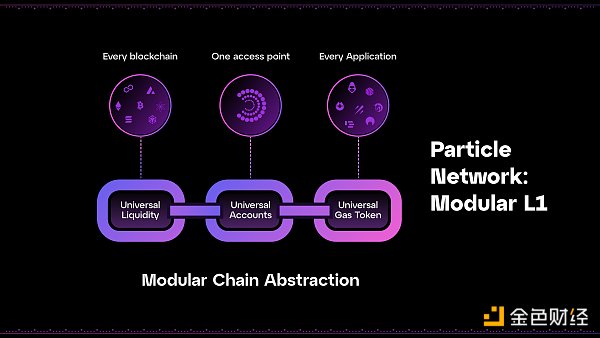
Universal account
Particle Network's universal account is supported by Layer-1 and is an ERC-4337 smart account implementation that can automatically route and execute atomic cross Chain transactions to aggregate token balances across all chains.
These accounts (which in turn leverage Particle's universal Gas token and universal liquidity) can be understood as smart account implementations assigned to existing EOAs that source Social login via Particle Network’s modular smart wallet-as-a-service, or standard Web3 and Bitcoin (via BTC Connect wallet). These account implementations automatically use the Particle Network to facilitate atomic cross-chain transactions, allowing them to maintain a unified state.
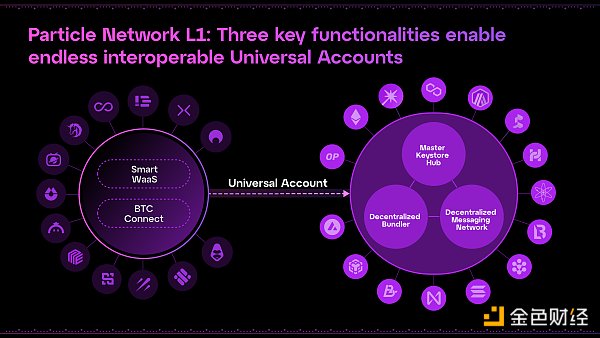
Universal Liquidity
Universal liquidity refers to the aggregation of balances on all chains and atomic cross-chain coordination by Particle Network Transactions and exchanges are driven directly.
For example, if a given user owns MATIC worth 1 ETH on Polygon, but performs a transaction on Optimism that requires 1 ETH, The Particle Network will then route and execute cross-chain transactions via the initial signature provided for its intended interaction. This enables value to be quickly transferred from Polygon to Optimism for related actions, creating a single balance across all blockchains The feeling.
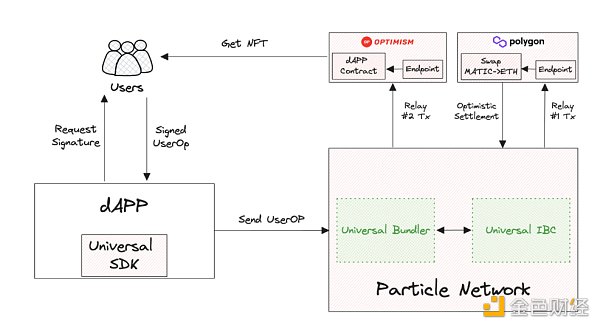
< p style="text-align: left;">User process of using Particle Network for cross-chain transactions (UserOperation)
General Gas Token
Given the unification of cross-chain balance, Particle Network also addresses the expected fragmentation of Gas tokens, providing a cohesive experience.
While most networks share a range of standard tokens (such as USDT), each blockchain requires a specific Gas token, thus requiring users to hold a large number of different tokens on the network . To solve this problem and further enable a truly universal experience, Particle Network launched the Universal Gas Token: a token directly available in universal accounts to pay gas fees on each chain. Therefore, cross-chain transactions only require this specific token to execute, rather than requiring separate tokens for each chain they use. This dynamic furthers the underlying goal of the chain abstraction to be accessible to users even when they do not hold universal gas tokens through automated exchanges, allowing them to pay for gas using any token.
BTC Connect
BTC Connect unifies users’ Bitcoin accounts and EVM-based intelligence Account, which implements account abstraction on Bitcoin. This is accomplished by having a Bitcoin wallet act as a signer for a smart account on the Bitcoin L2 or EVM network, allowing users to interact directly with their existing Bitcoin wallet without the need for additional interactions or interfaces.
The design introduces Smart Accounts, Paymaster, Bundler and a unique Bitcoin-specific wallet connection mode. The latter completes a local Bitcoin wallet connection (via UniSat, BitGet or OKX) by generating an EVM smart account to be "assigned" to the target Bitcoin wallet. This way, all interactions on the Smart Account and the original Bitcoin wallet can be controlled through the Bitcoin wallet's interface.
Interactions with user smart accounts can be funded directly by the account owner or prepaid by the dApp itself (via Paymasters). Therefore, users can interact with the protocol through gasless transactions or by paying gas using an asset on their smart account (usually BTC, but also other tokens, such as $USDT in some cases). This allows users to access AA on the EVM network without having to download additional plugins/applications or manage different keys.
BTC Connect extends the capabilities of Bitcoin wallets, allowing users to use a single wallet to send local Bitcoin transactions, interact with the Ordinal ecosystem, and run on compatible EVM dApps and execute logic on Bitcoin L2 (including no Gas and no pop-up window interaction).
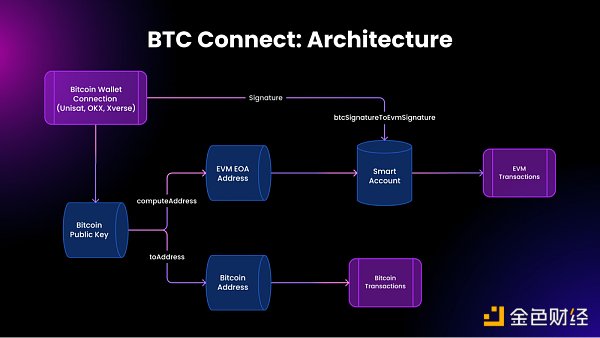
In summary, the public key of the user's connected Bitcoin wallet is used directly to execute native Bitcoin transactions and is used to generate the EVM EOA. This EOA is in turn used to create a smart account with the Bitcoin wallet as its signer. This makes Bitcoin wallet signatures compatible with EVM, allowing the same wallet to handle seamless AA-powered Bitcoin mainnet and Layer 2 transactions.
Token function
Native project tokens will be issued after the main network is launched. Its main functions are:
General Gas token:
Particle Network's token will serve as a key component in Particle's universal account model, powered by its modular L1. Transactions performed by a universal account (usually cross-chain operations) rely solely on this token for execution, without requiring multiple independent native Gas tokens.
Security:
The Particle Network Token secures Particle’s modular L1 through its dual-staking mechanism, acting as one half of its consensus model. It is staked alongside re-staking ETH to enhance network security.
Governance:
Token holders will have the opportunity to vote on public governance proposals that impact the operation of the Particle Network infrastructure.
Network tokens provide users with many benefits, including:
Convenience:
As mentioned above , Particle's Modular L1 will unify Gas payments through a single token, making the end-user experience of interacting with Web3 easier.
Adjust incentives:
Perhaps more importantly, the Particle Network Token turns dApps, other blockchains, developers, and Particle itself into growth partners. This model eschews the typical SaaS business model of wallet abstraction tools and greatly accelerates the growth of Particle Network.
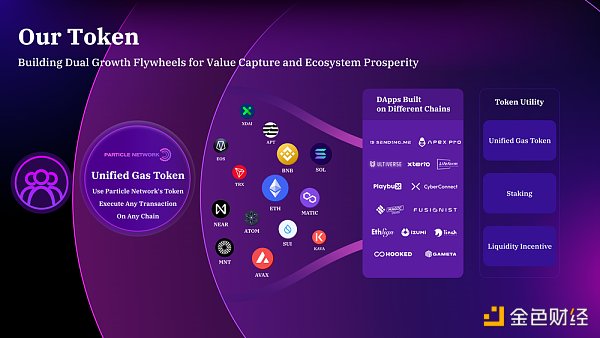
Team and financing information

The CEO and CTO of the project are both Chinese:
Wang Pengyu is the founder and CEO of Particle Network and the founder of Minijoy, a casual game platform in India and Europe and the United States. He has worked at China Renaissance and SAIF Investments and graduated from Tsinghua University.
Pan Tao is the co-founder and CTO of Particle Network. He has served as the CTO and overseas business leader of Desktop Games, and the co-founder of Minijoy, a casual game platform in India and Europe. , graduated from Tsinghua University.
In May 2022, it received US$1.5 million in Pre-seed financing led by LongHash Ventures, with a valuation of US$30 million;
In March 2023, it received US$7 million in seed round financing led by ABCDE Capital;
In April 2023, Received strategic financing from Cobo Ventures, an unknown amount.
Summary
Particle Network hopes to solve the current problems by building its own modular Layer1 The problem of multi-chain fragmentation and the goal of chain abstraction enable users to manage accounts and liquidity on different chains under a unified interface without having to download various wallets and conduct complex cross-chain transactions.
However, the various underlying cross-chain transactions need to be compatible with different standards. The experience may not be comparable to that of a single chain in the short term. At the same time, the technical details will be more complicated and difficult to implement. The difficulty is greater. At the same time, account abstraction sacrifices a certain amount of user security, and new users need to migrate assets when entering. This remains to be seen later.
 JinseFinance
JinseFinance JinseFinance
JinseFinance Wilfred
Wilfred Weatherly
Weatherly ZeZheng
ZeZheng ZeZheng
ZeZheng JinseFinance
JinseFinance JinseFinance
JinseFinance JinseFinance
JinseFinance JinseFinance
JinseFinance cryptopotato
cryptopotato